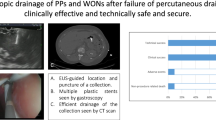Abstract
Background
The purpose of this study is to report our initial experience with a new fully covered metallic stent with a novel design (AXIOS) to prevent migration and fluid leakage, in the drainage of pancreatic fluid collections (PFC).
Methods
We included nine patients from four Spanish centers undergoing endoscopic ultrasound (EUS)-guided drainage of PFC with placement of an AXIOS stent. The lesions were accessed via transgastric (n = 7), transesophageal (n = 1), and transduodenal (n = 1) by using a novel access device (NAVIX) in six cases or a 19-G needle in three. Patients were individually followed prospectively for procedure indications, demographic data, previous imaging techniques, technical aspects, clinical outcomes, complications, and follow-up after endoscopic drainage.
Results
The mean size of lesions was 105 ± 26.3 mm (range, 70–150). In six cases, cystoscopy was performed through the stent, including necrosectomy in two. Median procedure time was 25 ± 13 min. A median number of two sessions were performed. The technical success rate was 88.8 % (8/9) due to one failure of the delivery system. One patient developed a tension pneumothorax immediately after transesophageal drainage. No migrations were reported, and all stents were removed easily. All patients had a successful treatment outcome achieving complete cyst resolution. Mean time to stent retrieval was 33 ± 40 days. Mean follow-up was 50 ± 1.3 weeks (range, 45–55), and only one patient presented a recurrence 4 weeks after the stent removal. Furthermore, comparison with ten previous consecutively recruited PFC cases drained by EUS-guided using plastic pigtail stents was done. Technical and clinical successes were similar. However, two stent migrations, two recurrences, and two complications were found. The number of stents used (n = 15) and the median procedure time (42.8 ± 3.1 min) were significantly higher.
Conclusions
Drainage of PFC using dedicated devices as this novel metallic stent with special design seems to be an effective, feasible and safe alternative technique.


Similar content being viewed by others
References
Sadik R, Kalaitzakis E, Thune A et al (2011) EUS-guided drainage is more successful in pancreatic pseudocysts compared with abscesses. World J Gastroenterol 28:499–505
Vila JJ, Carral D, Fernández-Urien I (2010) Pancreatic pseudocyst drainage guided by endoscopic ultrasound. World J Gastrointest Endosc 16:193–197
Kahaleh M, Shami VM, Conaway MR et al (2006) Endoscopic ultrasound drainage of pancreatic pseudocyst: a prospective comparison with conventional endoscopic drainage. Endoscopy 38:355–359
Sriram PV, Kaffes AJ, Rao GV et al (2005) Endoscopic ultrasound-guided drainage of pancreatic pseudocysts complicated by portal hypertension or by intervening vessels. Endoscopy 37:231–235
Cahen D, Rauws E, Fockens P et al (2005) Endoscopic drainage of pancreatic pseudocysts: long-term outcome and procedural factors associated with safe and successful treatment. Endoscopy 37:977–983
Lopes CV, Pesenti C, Bories E et al (2007) Endoscopic-ultrasound-guided endoscopic transmural drainage of pancreatic pseudocysts and abscesses. Scand J Gastroenterol 42:524–529
Talreja JP, Shami VM, Ku J et al (2008) Transenteric drainage of pancreatic-fluid collections with fully covered self-expanding metallic stents (with video). Gastrointest Endosc 68:1199–1203
Perez-Miranda M, Mata L, Saracibar E et al (2007) Temporary access fistulas (TAFs) using covered self-expandable metal stents (cSEMS): a feasible tool for interventional pancreaticobiliary endoscopy [abstract]. Gastrointest Endosc 65:AB123
Itoi T, Binmoeller KF, Itokawa F et al (2001) First clinical experience using the AXIOS stent and delivery system for internal drainage of pancreatic pseudocysts and the gallbladder. Gastrointest Endosc 73:AB330
Binmoeller KF, Shah J (2011) A novel lumen-apposing stent for transluminal drainage of nonadherent extraintestinal fluid collections. Endoscopy 43:337–342
Faigel D, Baron T, Lewis B (2005) Ensuring competence in endoscopy. Prepared by the ASGE taskforce on ensuring competence in endoscopy and American college of Gastroenterology executive and Practice management committees. ASGE policy and procedures manual for gastrointestinal endoscopy: guidelines for training and practice on CDROM. ASGE, pp 1–36
Bradley EL 3rd (1993) A clinically based classification system for acute pancreatitis. Summary of the International Symposium on Acute Pancreatitis, Atlanta, GA, September 11–13, 1992. Arch Surg 128:586–590
Baron TH (2008) Endoscopic drainage of pancreatic pseudocyts. J Gastrointest Surg 12:369–372
Antillon MR, Shah RJ, Stiegmann G et al (2006) Single-step EUS-guided transmural drainage of simple and complicated pancreatic pseudocysts. Gastrointest Endosc 63:797–803
Belle S, Collet P, Post S et al (2010) Temporary cystogastrostomy with self-expanding metallic stents for pancreatic necrosis. Endoscopy 42:493–495
Binmoeller KF, Weilert F, Marson F et al (2011) EUS-guided translumenal drainage of pancreatic pseudocysts using the NAVIX access device and two plastic stents: initial clinical experience. Gastrointest Endosc 73:AB331
Ayub K, Patterson D, Irani S et al (2009) Endoscopic ultrasound directed pseudocyst drainage without the use of fluoroscopy: a case series. Gastrointest Endosc 69:S234
Soderlund C, Linder S (2006) Covered metal versus plastic stents for malignant common bile duct stenosis: a prospective, randomized, controlled trial. Gastrointest Endosc 63:986–995
Acknowledgments
Participants listed bellow served in the study as scientific advisors: Modesto Varas-Lorenzo and Jorge C. Espinós. Endoscopy Unit, Centro Médico Teknon, Barcelona, Spain.
Disclosures
Drs. Gornals, De la Serna, Sanchez-Yague, Loras, Sanchez-Cantos, and Pérez-Miranda have no conflicts of interest or financial ties to disclose.
Author information
Authors and Affiliations
Corresponding author
Electronic supplementary material
Below is the link to the electronic supplementary material.
Video Endosonography-guided transgastric drainage of a pancreatic pseudocyst using a lumen-apposing metallic covered stent (WMV 22657 kb)
Rights and permissions
About this article
Cite this article
Gornals, J.B., De la Serna-Higuera, C., Sánchez-Yague, A. et al. Endosonography-guided drainage of pancreatic fluid collections with a novel lumen-apposing stent. Surg Endosc 27, 1428–1434 (2013). https://doi.org/10.1007/s00464-012-2591-y
Received:
Accepted:
Published:
Issue Date:
DOI: https://doi.org/10.1007/s00464-012-2591-y




